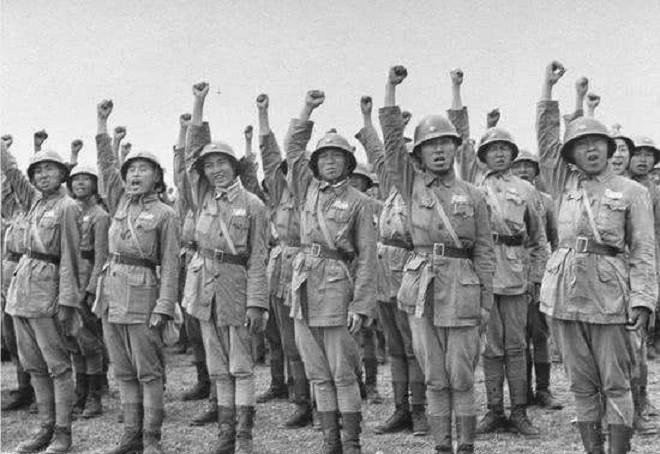What is history: it is the echo of the past to the future, the reflection of the future on the past. - Hugo
After the end of the War of Resistance Against Japanese Aggression, the War of Liberation broke out again, when the main battlefields of the whole country were divided into the Northeast Battlefield, the East China Battlefield, the Central Plains Battlefield, the Northwest Battlefield, and the North China Battlefield. Among them, the most important is the northeast battlefield, the Central Plains battlefield and the East China battlefield, these three battlefields were the main battlefields of the two sides at that time, for this reason, Chiang Kai-shek invested the most troops, but also the most capable of fighting. Compared with the battlefields of the Central Plains and east China, the Nationalist army not only invested a large number of people at that time, but also most of them were elite troops. Among them, there are four armies, the strongest of which is called the four elite units of the National Army on the Battlefield of the Central Plains.
The first elite unit was the reorganized 74th Division of the National Revolutionary Army, which was actually the 74th Army, the most capable of fighting during the War of Resistance. Friends who may know history know that the 74th Army is the first of the five aces of the Nationalist Army, performed very well during the War of Resistance Against Japanese Aggression, and won the reputation of the Tiger Army, the Royal Forest Army, and the Anti-Japanese Iron Army. During the Liberation War, it was reorganized into the 74th Division of the National Revolutionary Army. Although it was demoted from the army to a division, the reorganized 74th Division still maintained a strength of more than 30,000 people, and it was also equipped with a heavy artillery regiment, which was very strong in combat effectiveness.

Elite troops
To this end, on the battlefields of the Central Plains and East China during the Liberation War, the reorganized 74th Division brought great lethality to our army. Zhang Lingfu used the 74th Division to cross the two major battlefields, daring to lead the army to fight alone, and the whole division was very arrogant, so it also became the seed of the destruction of this ace unit. In the battle of Menglianggu, it was completely annihilated by the East China Field Army, becoming the first elite unit of the Nationalist Army to be annihilated during the Liberation War.
The second elite unit was the Fifth Army of the National Revolutionary Army, which was established during the War of Resistance Against Japanese Aggression and was also one of the five main forces of the Nationalist Army, known as the Iron Horse Division. At the same time, it is also the only mechanical army in the national army, which is well equipped and has strong combat effectiveness. Moreover, during the liberation period, the Fifth Army was not reorganized, and the post of commander was held by Qiu Qingquan, a fierce general of the Nationalist Army. Under his leadership, the army has made great achievements in the battlefield of the Central Plains. For example, the Xuzhou sweeping operation severely damaged the columns of the Yu and Anhui Soviets, continuously advanced forward, opened up the Pinghan Line, occupied important cities such as Handan, Puyang, and Daming, and caused heavy losses to the base areas of the Liberated Areas. In the Battle of Eastern Henan, the Fifth Army and Huang Baitao's integrated 25th Division defeated the East China Field Army in the whole line. However, a single Fifth Army could not save the fate of the defeat of the entire Nationalist Army. In the end, the soldiers were defeated on the Battlefield of Huaihai, and Qiu Qingquan was killed on the battlefield.
The third elite unit was the Reorganized 11th Division of the National Revolutionary Army, whose predecessor was the 18th Army and one of the five main forces of the Nationalist Army. After this ace army was formed into the 11th Division, Hu Lian was appointed as the division commander, and the three integrated brigades under its jurisdiction were all the same WhamPoa Sheng as the brigade commander. Therefore, during the liberation period, Hu Lian's 11th Division was also an ace army in the Central Plains Battlefield and the East China Battlefield. It has always served as a fire brigade, and wherever there is difficulty, it will be put into which battlefield. In the Battle of Nanma, Hua Ye mobilized four columns to besiege the 11th Division, and the two sides fought for three days and three nights, and as a result, the 11th Division successfully escaped by virtue of the heavy rain. In the Battle of Cao County, the 11th Division also inflicted heavy losses on our army. As a result, Grandpa Mao gave this unit a high evaluation.
The fourth elite unit was the Reorganized Seventh Division of the National Revolutionary Army, which belonged to the Gui army and was known as the Steel Army. Although it does not belong to the nationalist army, it is a bright star in the miscellaneous army, and its combat capability can be compared with Chiang Kai-shek's five main forces. At the same time, the reorganized Seventh Division was also ace in the hands of Li and Bai, which was regarded as the meat of the heart, and the successive commanders were all generals of the Gui clan. Moreover, the reorganized 7th Division was also the last ace of the Nationalist army to be destroyed.